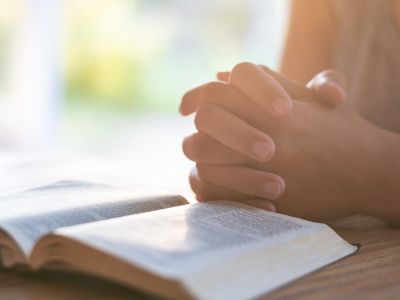 The entry on principles of mental prayer explains that there is no one method of mental prayer and that it is the best to approach mental prayer, but rather that there are universal guiding principles such as humility, trust and perseverance.
The entry on principles of mental prayer explains that there is no one method of mental prayer and that it is the best to approach mental prayer, but rather that there are universal guiding principles such as humility, trust and perseverance.
Be that as it may, we must start somewhere, and the Saints and other spiritual masters have repeatedly pointed to methods summarized with “R’s” as a preferred way to begin with Christian meditation. You’ll see these methods summarized with anywhere from three to five R’s. Here we’ll work with four R’s: Relate, Read, Reflect, Resolve. You’ll find many versions of these steps, sometimes with different names, different order or with different steps combined, but all work to the same end.
Relate: Take a few minutes to bring yourself into the presence of God. St. Ignatius of Loyola describes this as entering into His gaze. God is already there with you, gazing down upon you. This is a time to turn your gaze from worldly things to God. You might find it helpful to think of yourself as physically turning toward Him. And, for the baptized in a state of grace, you might also call to mind that God dwells within you. This step can also be thought of as Recollecting yourself.
Read: Enter into Scripture or other good spiritual reading. This is decidedly a case of quality over quantity; you may only end up reading a few sentences. The simplest and best place to start is with Scripture – particularly Gospels and Psalms (Fr. Bartunek’s The Better Part provides excellent reflections on each of the Gospels). There are many other good books for reflection (e.g. St. Francis DeSales’ Introduction to the Devout Life, Bishop Fulton Sheen’s The Way of the Cross, Fr. Jacques Phillipe’s Time for Prayer). Likewise, the song reflections in Inspiring Songs are tied with scripture and specifically crafted as starting points for meditation.
Reflect: Now is the time to enter into deeper meditation with your reading. As you read, when something captures your attention, pause and sit with it. Invite the Holy Spirit to bring you light and insight. Savor the small details. Place yourself into the particular passage. If it’s a seen in the Gospel, put yourself in it. What are the sounds, smells, sights and activities going on about you? Why did the Holy Spirit guide you to that particular passage? What is God specifically and personally saying to you?
Resolve: As you come to the end of your meditation it is appropriate to give thanks to God for his goodness. Thank God simply for the gift of spending time with Him and for the revelation He’s given you through this time of meditation. Even if meditation “felt” dry, have utmost faith that it was fruitful but in ways unknown to you at the moment. Thanksgiving should flow into a resolution. Determine one concrete action you can take for the rest of the day to put into practice what was revealed to you by the Holy Spirit. For example, anytime someone starts to annoy you or try your patience, you will say a quick prayer for that person. If you can’t come up with a specific resolution, then take a phrase, thought or image from your reflection and repeat it throughout the day.
Resolution should also include Reconciliation. We often are shown a specific shortcoming as part of our reflection. Resolution is a good time to ask the Lord’s forgiveness (and to determine to bring this to the Sacrament of Reconciliation). This self-awareness can also be a good source for a daily resolution focused to counteract the specific shortcoming.
